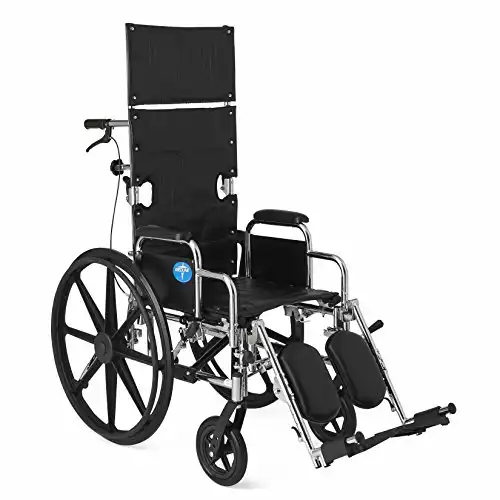In a Nutshell:
The Medline Excel Reclining is a surprisingly modestly priced and capable reclining wheelchair that’s relatively light, too! Recommended for anyone weighing up to 350 pounds who wants or needs a good reclining wheelchair that’s light enough to take on the road with you.
Affordability
Durability
Maneuverability
Usability
Brand Reliability*
Overall Rating
4.2/5
Benefits
- Relatively small and lighter than most peers
- Inexpensive for a reclining wheelchair
- Super easy to use
Drawbacks
- Limited recline angle (maximum 140 degrees)
- Lacks extras beyond anti-tippers
- Upholstered in vinyl, potentially less desirable
Recommended For: Anyone weighing up to 350 pounds who wants or needs a good reclining wheelchair that’s light enough to take on the road with you.
Do you love your trusty recliner? Are you interested in replicating that experience in your wheelchair?
Or perhaps you have a mobility issue that’s serious enough that you’re forced to spend extended periods of time in your chair, in which case, a reclining variant just makes sense?
If you answered yes to either of the questions above, you’re going to like what you read in this Medline Excel Recliner wheelchair review.
While Medline isn’t one of the giants of the wheelchair industry, they have been in the business for a long time and has a reputation for both quality and post-sales support. Their reclining wheelchair is an unexpectedly good model and a pleasant surprise.
In the sections that follow, we’ll go over the chair in detail, telling you what the design team for this chair got right and not pulling any punches when it comes to describing this model’s shortcomings and limitations. That way, you’ll have all the information you need, right at your fingertips, so you can decide for yourself if this is the model you’ve been searching for.
Even if it’s not, we think you’ll be impressed. Let’s take a closer look.
An Overview of the Medline Excel Reclining Wheelchair
The first thing you’ll notice about this chair is that the designers more or less stuck to the convention.
Sure, it’s taller than your average wheelchair, but that’s true of any reclining model.
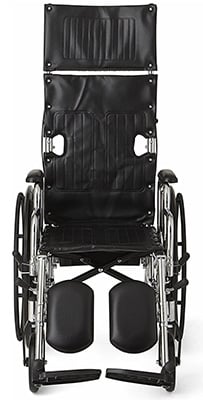
With black upholstery on a black frame and a few chrome highlights, the only real nod to aesthetics that the design team gave this model was the inclusion of mag wheels. They look nice, no doubt, but by themselves, they’re not enough to lend this chair what one would describe a sporty appearance.
That’s not really a problem for most people. After all, if you need a wheelchair for one reason or another, the odds are good that you’re going to care a lot more about function than form.
Specifications
Before we start talking about the specific features this model brings to the table in this section of our Medline Excel Recliner wheelchair review, let’s take a quick look at the core stats. Here are the basics:
- Overall Product Dimensions: 26.5” (W) x 34.2” (D) x 40.5” (H)
- Seat Dimensions: 20” (W) x 17” (D) (Note – multiple seat width options available – see details below)
- Chair Weight: 46 pounds
- Maximum Supported Weight: 350 pounds
There’s a lot to like about these numbers. First and foremost, the chair is narrow enough that it will fit through a standard doorway, although you won’t have much room to spare. With that in mind, the standard warning about watching your knuckles on the pass-through applies.
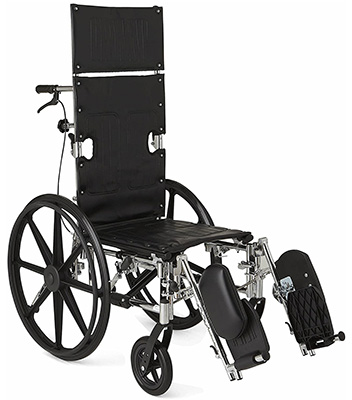
The big thing to talk about here is the seat options. Although we’re focused on the 20” x 17” seat, you can order this chair with your choice of the following seat configurations:
- 22” x 17”
- 20” x 17”
- 18” x 17”
- Or 16” x 17”
If you get the wider seat, add 2” to the chair’s width and note that it will still (just barely) fit through a standard-width door. If you get the smaller seats, subtract either 2” or 4” from the total width (for the 18” or the 16” models, respectively).
Also note that the 18” or 16” seats will come on a slightly less robust frame that will support a maximum of 300 pounds, instead of the 350 offered by the specific variant we’re looking at here.
The weight is actually excellent for a reclining wheelchair. We’ve seen some that weigh 60, 70, and even up to a hundred pounds. This model is a bit heavier than a standard wheelchair, to be sure, but not by a lot. At 46 pounds, most people won’t have too much trouble folding it, finding a place to store it, and taking it on the road with them. That’s a good thing and the mark of a truly versatile chair.
Adjustability and Comfort
Where adjustability is concerned, the big thing to talk about here is, of course, the chair’s recline feature. It offers an infinite number of recline positions, but there’s a catch: The recline angle ranges only from 90 to 140 degrees.
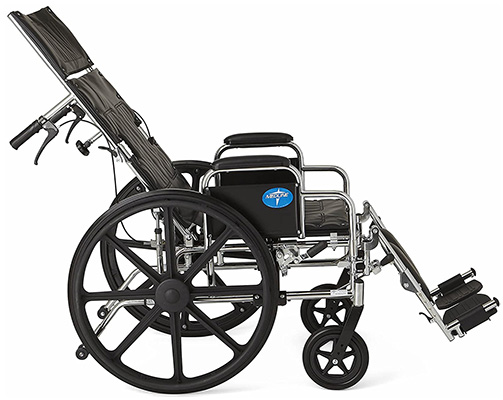
For most people, that’s plenty, but if you’re specifically looking for a chair that will lay completely, or even mostly flat, this is not the one you want.
You can still nap in it, certainly, but the limited recline range is something to bear in mind, and it may be sufficient to cause you to take a pass where this model is concerned.
In addition to an infinite number of recline positions, the Medline Excel Reclining wheelchair is also a Hemi-height chair, offering you either a 17.5” or a 19.5” seat height. Depending on the length of your legs, if you use the low setting, you may be able to move around in the chair using your feet.
This model also features length-adjustable leg rests. Combined with the height adjustment options, that actually gives you a fair amount of flexibility in tweaking the chair’s settings to provide optimal comfort.
Speaking of comfort, the leg rests on the chair feature calf pads, and the leg rests themselves elevate, so you can kick your feet up while you’re reclining.
Although the desk-length armrests aren’t height-adjustable, they do flip back, which makes transferring into and out of the chair easier, and they’re padded for extra comfort.
We’re not completely sold on the idea of using desk-length arms for this chair. People usually buy recliners (both chairs and wheelchairs) because they plan to spend significant amounts of time in them, in which case, full-length arms would be the better choice.
On the other hand, the desk-length arms offered here do serve to make this a more versatile chair.
When you’re not reclining, you can wheel up to your desk and work from your trusty chair, without having to transfer to an office chair.
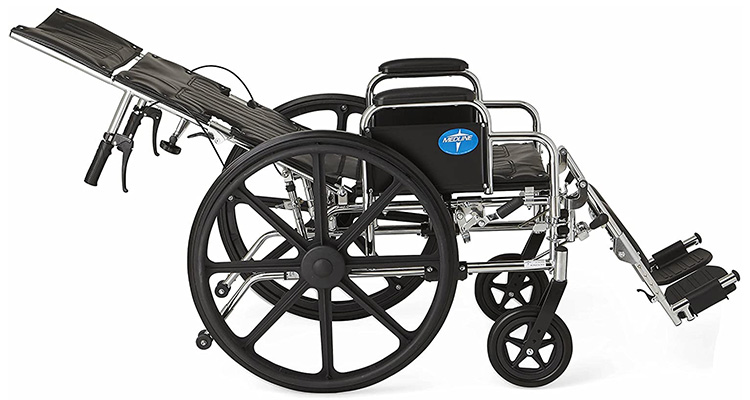
Similarly, if you want to enjoy dinner with your family, there’s no need to transfer out of the wheelchair and into a dining chair. You can just roll right up to the table.
All that to say, we get it. There’s value in desk-length arms.
Having said that, though, this model would be more comfortable with full-length arms, and it would be consistent with the overall theme of the chair.
The upholstery is a problem, in our view. It’s vinyl.
Vinyl gets hot. It isn’t breathable. If you plan to spend lots of time sitting in your chair, you’ll run into the limitations of vinyl fairly quickly (about four hours into sitting in the chair, maybe more, maybe less depending on the climate where you live).
The other problem is that vinyl isn’t all that durable. It won’t stand up well to the rigors of heavy daily usage. You can expect the vinyl to start showing its age after about 18 months, no matter how careful you are with it.
The good news is, that’s a super easy problem to fix. Just buy a pad for the seat and seatback, and you kill two birds with one stone.
You’re not sitting on the vinyl, so it won’t make you hot and you won’t wear it down nearly as quickly. Even better, there are tons of vendors out there selling everything from memory foam to conventional padding, so you’ve got plenty of options where that’s concerned.
Extras and Options
As is the case with most reclining wheelchairs, the Medline reclining wheelchair comes with anti-tippers as a standard feature.
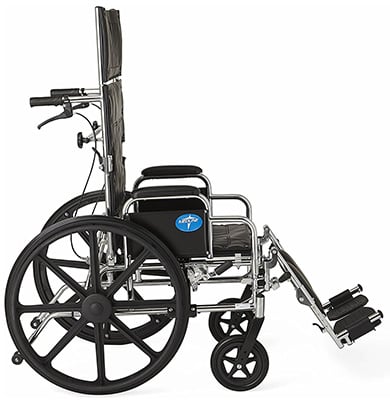
Any time anti-tippers are included, we’re happy. Honestly, they’re such an important safety feature, we feel they should be standard on every wheelchair sold, but the simple truth is, they’re not. In any case, we’re glad to see them here.
The other ‘extra’ that comes with this chair is a small, detachable headrest pillow. It’s not a world-class pillow and not the most comfortable in the world, but it gets the job done.
Unfortunately, those are literally the only two extras that come standard with the chair. If you want storage, you’ll have to buy it separately.
If you want a cup holder, an O2 holder, or any other enhancement, you’ll have to invest in them separately.
On the one hand, that’s not really the end of the world. The chair is basically a blank slate, giving you the freedom and flexibility to add whatever you want to it as funds allow.
Just bear in mind that the more stuff you have to buy to make the chair the way you want it, the more the cost of ownership increases. Even so, this chair is modestly priced, so that’s not usually a huge problem.
Portability & Ease of Use
We give this chair high marks for both portability and ease of use. Of course, that’s relative. Compared to a conventional wheelchair, this model is neither, but that’s not really a fair comparison. Compared to other similarly priced reclining wheelchairs, this one’s amazing.
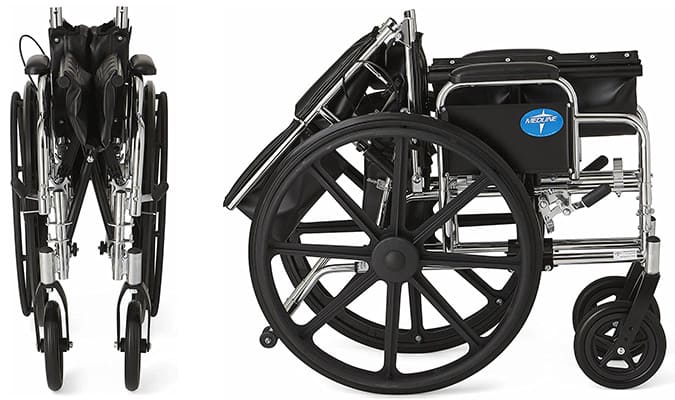
It’s significantly lighter than most other reclining wheelchairs, and it’s easy to operate.
Since it doesn’t weigh as much as most of its peers, it doesn’t require as much strength to get it moving, and it’s not as difficult for an assistant to push you from A to B.
It’s also surprisingly narrow, which means that you’ll be able to navigate through fairly tight spaces that larger reclining wheelchairs couldn’t. That’s helpful if you’re living with or visiting someone who lives in a smaller home or apartment. It also makes this a great chair to take with you in an RV for some overland adventuring.
One thing to be mindful of though is the wheels. Sans tread, they’re optimized for flat-level surfaces like parking lots, shopping centers, sidewalks, and most indoor floors. They’re not so good in parks or other open ground, and they’re a disaster on hiking trails.
Think carefully about how you intend to use this chair, and if you mean to take it onto rougher terrain on a regular basis, you’ll definitely want to upgrade the wheels.
Pros & Cons of Medline Reclining Wheelchair
In no particular order, the biggest strengths with this design as we see them are:
- It’s relatively small and lighter than most of its peers
- It’s inexpensive for a reclining wheelchair
- And it’s super easy to use.
On the other hand, it only reclines to a maximum angle of 140 degrees; it doesn’t come with any extras beyond anti-tippers, and it is upholstered in vinyl. While none of those are outright deal-breakers for most people, taken together, they might be.
Medline Excel Recliner Wheelchair Review Conclusion
We really like the Medline Reclining Wheelchair, but we don’t love it. As mentioned in the previous section here in our Medline Excel Recliner wheelchair review, this is a well-designed model, with the possible exception of the desk-length arms, which we can’t quite get behind.
Still, it gets the job done and is modestly priced, and there’s a lot to be said for that. We recommend this model.
Official Manufacturer Support
References & Resources:
- Medline, Official Brand Website.
- Medline Excel Recliner Wheelchair User Manual.
- Evaluation of the Effect of Different Sitting Assistive Devices in Reclining Wheelchair on Interface Pressure, NCBI.
- Effectiveness and Use of Tilt-in-Space and Recline Wheelchairs, RESNA.
- Effect of Durations of Wheelchair Tilt-in-Space and Recline on Skin Perfusion Over the Ischial Tuberosity in People With Spinal Cord Injury, ScienceDirect.
